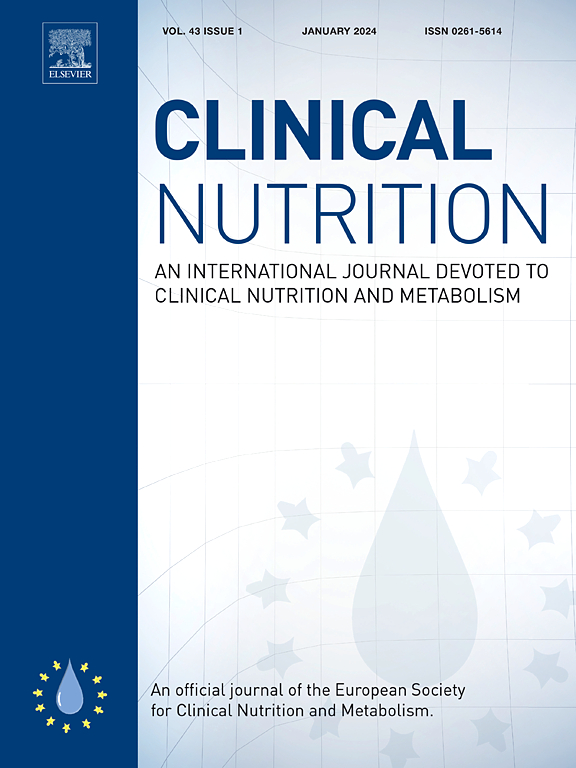肠内装置是肠衰竭儿童中央线相关血流感染的危险因素吗?
IF 6.6
2区 医学
Q1 NUTRITION & DIETETICS
引用次数: 0
摘要
背景与目的:中心线相关性血流感染(CLABSI)是儿童肠衰竭(IF)最常见和最严重的并发症之一。本研究旨在评估在调整临床相关因素后,肠内装置(喂食管和造口器)的使用与CLABSI发生率之间是否存在关联。其次,评估肠内装置与第一次CLABSI事件发生时间之间的关系。方法:回顾性队列研究了2006年1月至2017年12月期间在病童医院接受IF和家庭肠外营养治疗的202名儿童,随访时间至少为12个月。采用负二项多变量回归模型评估与CLABSI发生率相关的因素。采用Cox比例风险回归模型评估与第一次CLABSI事件发生时间相关的因素。结果:使用饲管[RR 1.10 (95%CI 0.88-1.37);p = 0.407]或stomas [RR 1.00 (95%CI 0.82-1.22);p = 0.974]在校正混杂因素后与CLABSI发生率无关。早产史与早产史之间存在显著相关性[RR 1.36 (95%CI 1.09-1.70);p = 0.007],男性[RR 1.28 (95%CI 1.05 ~ 1.56);结论:饲管和造口与CLABSI发生率增加或CLABSI首次发作时间无关。然而,早产,男性,年龄诊断肠衰竭本文章由计算机程序翻译,如有差异,请以英文原文为准。
Are enteral devices risk factors for central line-associated bloodstream infections in children with intestinal failure?
Background & aims
Central line-associated bloodstream infections (CLABSI) represent one of the most common and serious complications in children with intestinal failure (IF). This study aimed to assess if there is an association between the use of enteral devices (feeding tubes and stomas) with rate of CLABSI after adjusting for clinically relevant factors. Second, association between enteral devices with time to first CLABSI event was evaluated.
Methods
Retrospective cohort of 202 children with IF and home parenteral nutrition treated at The Hospital for Sick Children between January 2006, and December 2017, with a minimum of 12 months of follow-up. Negative binomial multivariable regression model was used to assess factors associated with rate of CLABSI. Cox proportional hazard regression model was used to assess factors associated with time to first CLABSI event.
Results
The use of feeding tubes [RR 1.10 (95%CI 0.88–1.37); p = 0.407] or stomas [RR 1.00 (95%CI 0.82–1.22); p = 0.974] was not associated with rate of CLABSI after adjusting for confounding factors. There was a significant association between history of prematurity [RR 1.36 (95%CI 1.09–1.70); p = 0.007], male sex [RR 1.28 (95%CI 1.05–1.56); p = 0.016], age at diagnosis of intestinal failure <1 year [RR 2.41 (95%CI 1.75–3.33); p < 0.001], having <50 % of small bowel length expected for age [RR 2.39 (95%CI 1.87–3.05); P < 0.001], and small bowel bacterial overgrowth (SBBO) [RR 1.38 (95%CI 1.10–1.74); p = 0.006], with rate of CLABSI events after multivariable analysis. The use of feeding tubes [HR 0.79 (95%CI 0.49–1.26); p = 0.315] or stomas [HR 1.25 (95%CI 0.81–1.94); p = 0.308] was not associated with time to first CLASBSI episode after multivariable regression analysis. Only length of small bowel <50 % was associated with time to first CLABSI event on multivariable analysis [HR 1.83 (95%CI 1.14–2.93); p = 0.012].
Conclusion
Feeding tubes and stomas were not associated with increased rate of CLABSI or time to first CLABSI episode. However, prematurity, male sex, age at diagnosis of intestinal failure <1 year, having <50 % of small bowel length expected for age, and SBBO were associated with rate of CLABSI events; and having <50 % of small bowel length was associated with time to first CLABSI event. Prospective, multicenter studies accounting for care delivery and prevention bundles are needed to identify patients that would benefit from additional interventions to prevent CLABSI.
求助全文
通过发布文献求助,成功后即可免费获取论文全文。
去求助
来源期刊

Clinical nutrition
医学-营养学
CiteScore
14.10
自引率
6.30%
发文量
356
审稿时长
28 days
期刊介绍:
Clinical Nutrition, the official journal of ESPEN, The European Society for Clinical Nutrition and Metabolism, is an international journal providing essential scientific information on nutritional and metabolic care and the relationship between nutrition and disease both in the setting of basic science and clinical practice. Published bi-monthly, each issue combines original articles and reviews providing an invaluable reference for any specialist concerned with these fields.
 求助内容:
求助内容: 应助结果提醒方式:
应助结果提醒方式:


